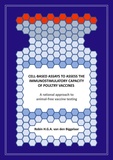Cell-based assays to assess the immunostimulatory capacity of poultry vaccines
A rational approach to animal-free vaccine testing
Summary
More than a million animals are used annually in the European Union for regulatory batch testing of medicinal products, predominantly for potency assessment. A quarter of these tests are classified as causing severe pain and distress. With respect to inactivated poultry vaccines, most potency tests are still performed in vivo due to the lack of in vitro alternatives. It is important to move away from in vivo testing because of ethical concerns, variability, long duration and high costs of these tests, risks for personnel working with infected animals, and legal requirements to use in vitro methods instead of in vivo methods whenever possible. The primary aim of this thesis was to set up in vitro cell-based assays to assess the immunostimulatory capacity of inactivated poultry vaccines and to determine their applicability for routine potency testing.
The studies presented in Chapters 2 and 3 of this thesis focus on the immunostimulatory properties of inactivated poultry vaccines by investigating their effect on chicken macrophages. Macrophages have a clear role in the early immune response and express a broad range of pattern recognition receptors, and are therefore able to sense immunostimulatory properties of vaccine constituents. The cell-based assays described involve the use of the macrophage-like cell line HD11, which has been used before to investigate the capacity of pathogens to stimulate innate immune cells. A phagocytosis assay with IgY-opsonized beads was used to investigate whether inactivated poultry vaccines against infectious bronchitis virus (IBV), Newcastle disease virus (NDV) and egg-drop syndrome virus (EDSV) affect phagocytosis by macrophages. In addition, the use of nitric oxide production and cytokine gene expression are described to determine the immunostimulatory properties of an inactivated octavalent vaccine against IBV, NDV, EDSV and five strains of Avibacterium paragallinarum, the causative agents of infectious coryza characterized by an acute respiratory disease in chickens.
Due to their long lifespan, low variability, and availability in large numbers, immortalized cell lines may be more suitable for quality control settings than primary cells. However, immortalized cell lines may have reduced sensitivity or impaired immune responsiveness as compared to their primary cell counterparts. Furthermore, dendritic cells, rather than macrophages, are considered to be most important for the induction of an immune response, and dendritic cell lines of chicken origin are not available. The study presented in Chapter 4 describes a thorough morphological, phenotypical and functional characterization of chicken bone marrow-derived dendritic cell cultures, using similar cell culture methods as previously described by others. In Chapter 5, exposure of the bone marrow-derived dendritic cells to an inactivated poultry vaccine against IBV and NDV is described. The purpose of this study was to identify biomarkers of vaccine-induced immune responses by proteomic analysis. Furthermore, the mechanisms by which inactivated poultry vaccines activate dendritic cells were explored.
Currently, the quality of inactivated poultry vaccines is often determined in vaccination-challenge or serological tests. The induction of humoral immunity is known to be an important aspect of vaccination with inactivated poultry vaccines. In contrast, knowledge about the induction of T cell-mediated immunity is still limited, although there are studies that have demonstrated a role for cellular immunity in the protection against IBV and NDV. The study of Chapter 6 describes a T cell proliferation assay to evaluate cellular immunity in laying hens vaccinated with an inactivated vaccine against IBV and NDV and its potential as a quality test for this vaccine.
In Chapter 7, a review describes the difficulties that are being encountered during the transition from in vivo to in vitro batch testing of vaccines for both human and veterinary use, as well as possibilities to overcome these difficulties. Topics include the critical quality attributes of vaccines that require testing, the use of cell-based assays to mimic relevant aspects of in vivo vaccine-induced immune responses, the difficulties of adjuvanted and multivalent vaccines and how to overcome these, the use of altered batches to validate in vitro test methods when non-compliant vaccine batches are limitedly available, and how cooperation between different stakeholders is key to move the transition forward. Finally, the findings of this thesis, as well as the next steps required for the transition in vitro potency testing of inactivated poultry vaccines, are discussed in Chapter 8.
